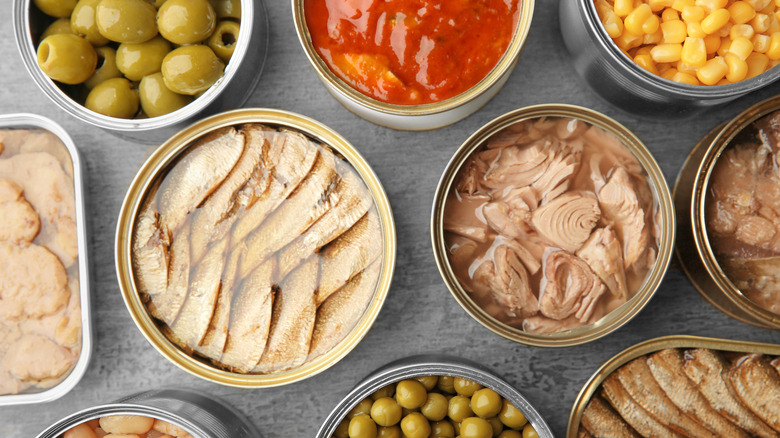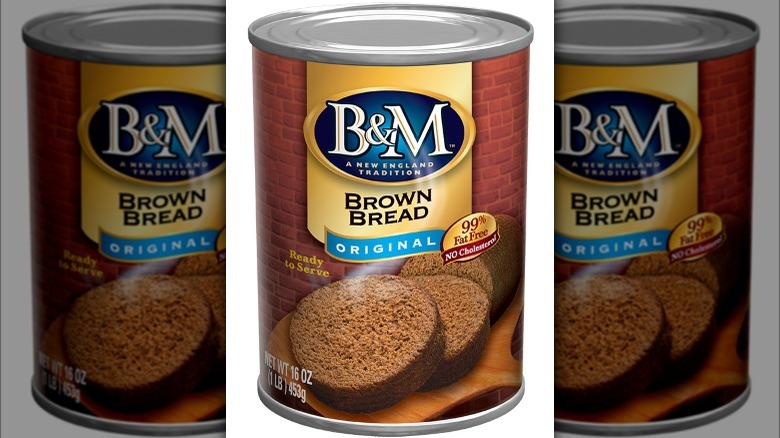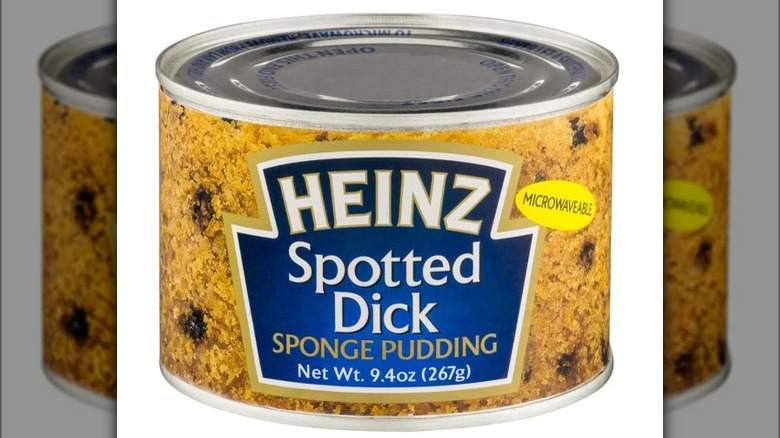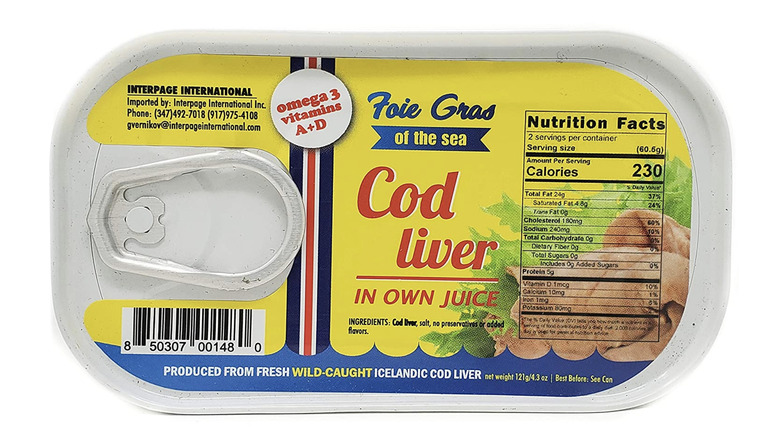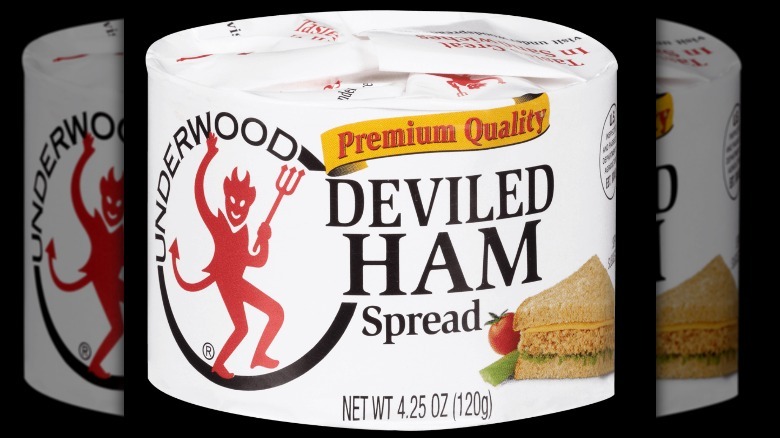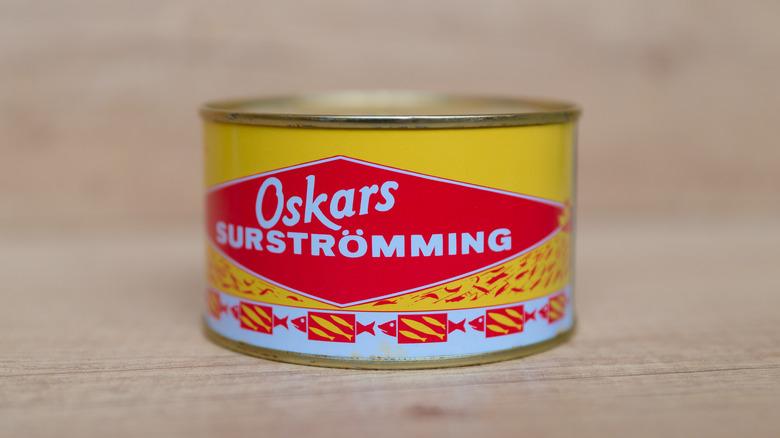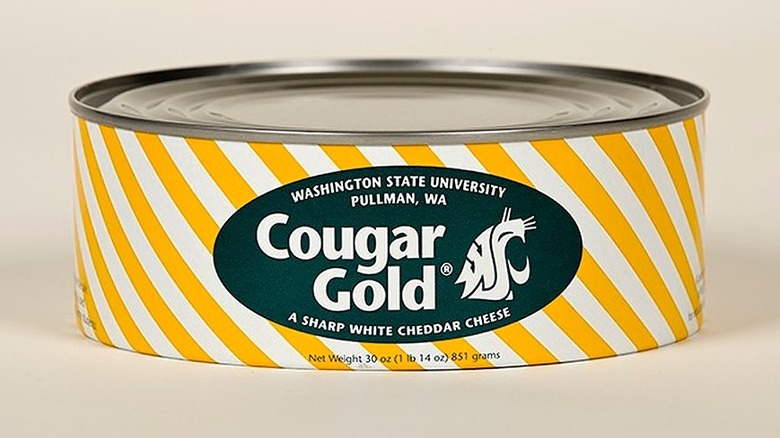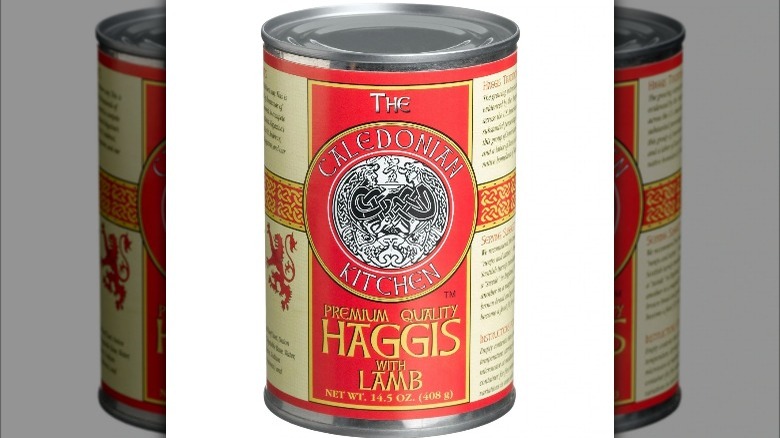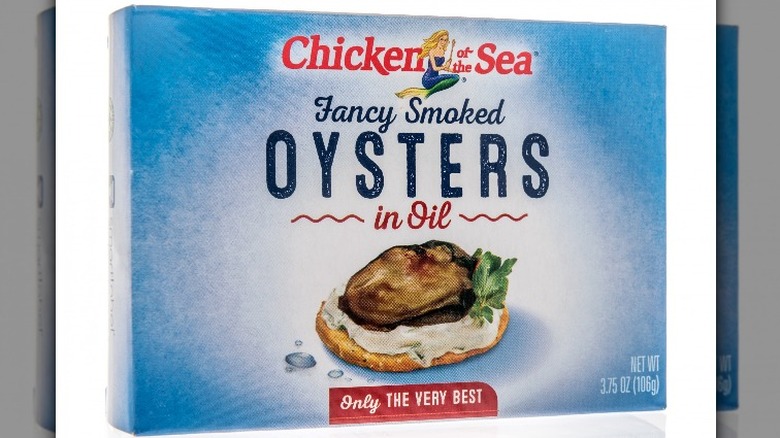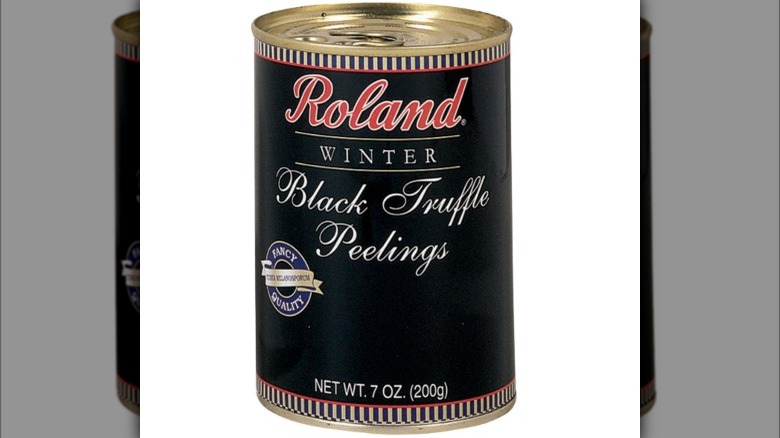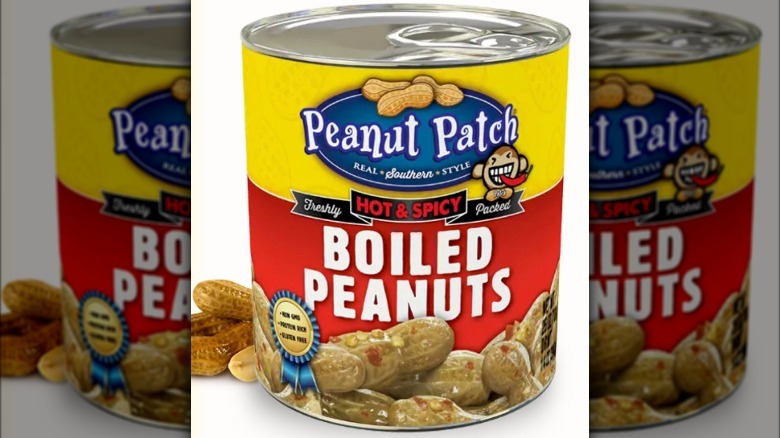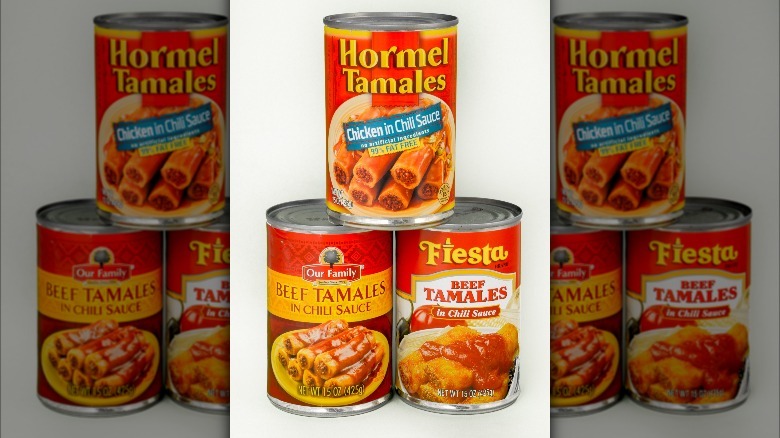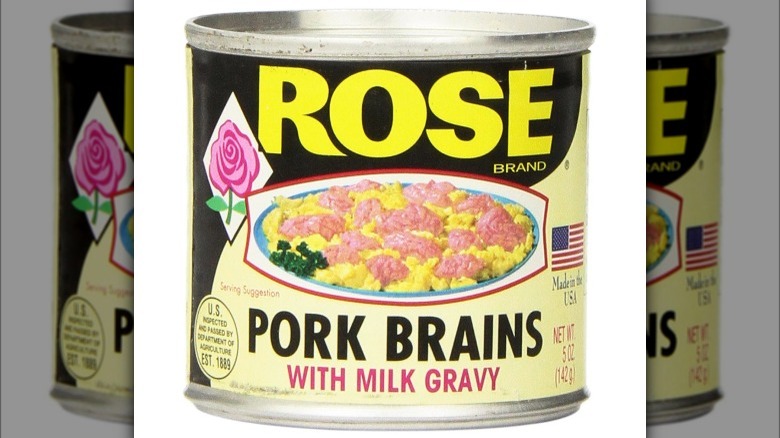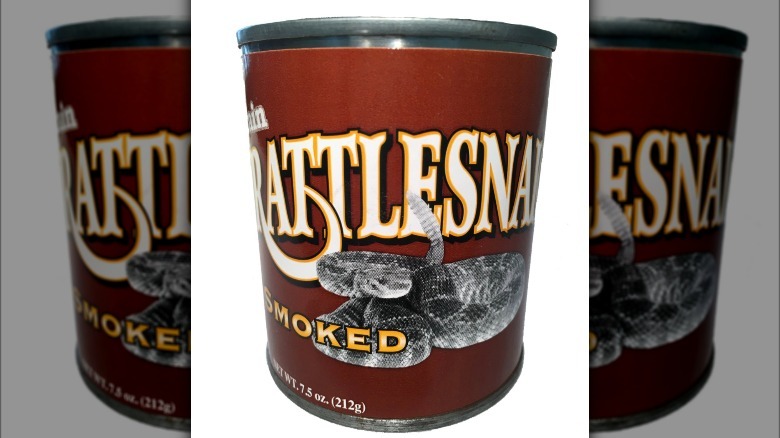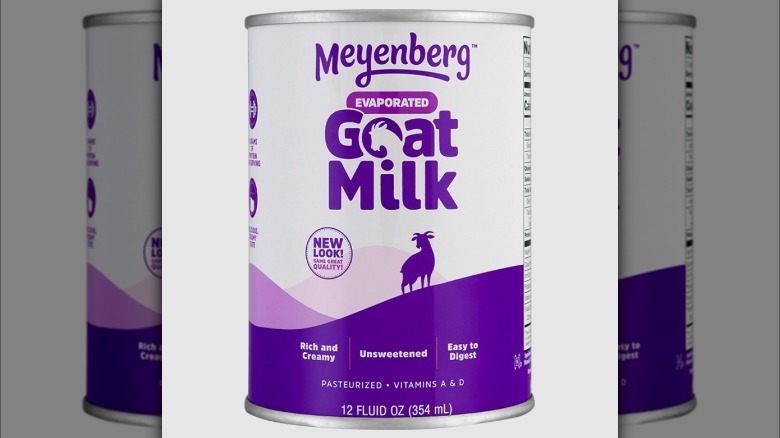Unusual Canned Foods You Need To Try At Least Once In Your Life
We may receive a commission on purchases made from links.
Ever since the French inventor Nicholas Appert figured out a reliable way to can food in the early 1800s, humanity has looked at these humble vessels and asked, "What can we shove in there?" From Spam to Campbell's soup to Chef Boyardee ravioli, there's almost no limit to the variety of comestibles we've sealed in cans over the years. Canned food, with its convenient format and zero need for refrigeration, is incredibly useful to have around. We bet just about every person reading this article has a couple of canned items sitting in their pantry right now.
One thing canned food isn't, however, is exciting. Nobody over the age of five thinks of SpaghettiOs as a thrilling food experience. It doesn't have to be this way though, and there are numerous canned foods that aren't boring and are in fact, downright unusual. Not only are these foods unique, but they're often quite delicious. This list highlights some of the tastiest unusual canned foods you can buy. Keep a few of these in your cupboard for the next time you want to crack open a can of adventure while sitting in the comfort of your own kitchen.
Canned bread
If you thought canned bread was made up for a throwaway gag in an episode of Spongebob (via YouTube), we have some news for you: Not only is it a real item that's been around for ages, but it also tastes great. According to New England Today, B&M, a New England-based canning company famous for its baked beans, started canning Boston brown bread sometime during the 1920s.
Like baked beans, brown bread has a strong molasses flavor, and also contains whole wheat flour, cornmeal, salt, leavening, and sometimes raisins. Per Gastro Obscura, people have been making this type of bread in New England since the 17th century, although the canned variety is a more recent innovation. Boston brown bread is uniquely suited to canning because, unlike most bread, instead of being baked it's traditionally steamed inside a metal container. The result is very sweet and moist, and it is frequently served with another sugary New England specialty, baked beans, for a dinner that verges on dessert. It's also delicious simply toasted and buttered for breakfast.
Heinz canned spotted dick
Yes, we know: This food has a funny name that can be used as the basis for an infinite number of juvenile jokes. However, the name doesn't mean what the childish part of your brain thinks it does. According to British Food History, spotted describes how the dessert is speckled with dry currants. Meanwhile, the source indicates that dick comes from the Old English term puddick referring to pudding. If you're from the U.S., you might be thinking that spotted dick doesn't look like the goop you find in little plastic cups in grocery stores. That's because as Vox explains, in British English pudding either means any kind of dessert or a dish that's steamed or boiled inside a container. Spotted dick actually fits both British definitions of pudding, as it's a steamed dessert.
In its recipe for spotted dick, the BBC Good Food calls for the traditional ingredient suet, aka raw beef fat. If you don't feel like trying to source suet and currants to make the BBC version from scratch, Heinz has you covered with its canned spotted dick. Simply microwave it or boil it inside the can, whip up some custard to serve over top, and you're set.
Canned cod liver
We admit that the description of this tinned delicacy may not sound super appealing, but canned cod liver is a luxurious snack that deserves to find its way onto more appetizer platters stateside. It's often produced in Northern Europe; you can find a Danish smoked version from Simply Gourmand or order an Icelandic non-smoked variety on Amazon.
If you've never tried cod liver before, think of it as the pâté of the sea. Pâté made from geese or duck fatty livers is widely accepted as gourmet, so why not give cod liver a try? It's incredibly rich and creamy with a mildly briny flavor from the sea, and it's soft enough that you can easily spread it on crackers or bread. In addition to its gustatory pleasures, cod liver is also super good for you. According to WebMD, cod liver oil is high in vitamin D, vitamin A, and healthy omega-3 fatty acids. People in Northern Europe have historically relied on fish oil to give them the vitamin D they require during the region's long, dark winters.
Canned deviled ham spread
Unlike many of the foods on this list, canned deviled ham spread is pretty easy to find at most grocery stores, but its appeal is still niche enough that many of you have probably never had it before. It's a canned version of a classic spread that you can make at home if you're in the mood. As for the devil, Food Republic explains that the term deviled originated in the 18th century and refers to heavily seasoning foods with pepper or mustard.
Underwood deviled ham consists of finely minced ham mixed with seasonings. Although canned meats have a bad reputation as mystery foods laden with chemicals, the ingredients list of Underwood's product is reassuringly small, with just two basic components: brown sugar-cured ham and a seasoning blend made of mustard, turmeric, and other spices. Deviled ham spread is rich, salty, and a little spicy, perfect for making party hors d'oeuvres.
Surströmming
It's important to note that what counts as unusual canned food for one person can be someone else's beloved food tradition. No product proves that point more than surströmming, a delicacy from Northern Sweden. Surströmming is a type of preserved Baltic Sea herring that gets its pungent odor from fermentation. The dish was invented to stretch scarce and expensive salt by using as little of it as possible to cure the herring. The Swedish Surströmming Supplier explains that as a result, the fish undergoes lactic acid fermentation, a process that produces a lot of hydrogen sulfide, a chemical that smells like rotten eggs. However, if you open the can outside, most of the smell dissipates making it easier to tolerate.
This product is rather infamous on the English-speaking internet for being, in BuzzFeed's words, "The Smelliest Food in the World." A YouTube search pulls up countless videos of (mostly non-Swedish people) doing the Surströmming Challenge, where they try to eat the fish straight out of the can, often unsuccessfully. The Swedish Surströmming Supplier sells the product to fans and novices alike, leaning into the food challenge angle with a page dedicated to it and a starter pack for sale. However, the site also goes to great pains to point out that surströmming is a traditional food that is legitimately enjoyed by many people. If you're ready to try surströmming, serve it the classic way wrapped in flatbread with sliced boiled potatoes and raw onions.
Canned cheese
When you think of canned cheese, you probably imagine something that's sprayable or spreadable like Kraft Easy Cheese, Cheez Whiz, or canned nacho cheese sauce. While these products all serve their purpose, the bright orange cheese product in those cans could hardly be called gourmet. There is, however, one manufacturer producing cheese in a can that you could happily serve at a fancy party: the Washington State University Creamery.
As Gastro Obscura explains, the university's product known as Cougar Cheese is a product of 20th-century food science innovation. Traditional natural cheese does not can well, as the bacteria that turns milk into cheese produces carbon dioxide gas as a byproduct of the fermentation process. Fermentation continues even after the cheese is canned which can cause the cans to bulge or even pop. Washington State University figured out that by adding a newly-invented bacterial strain, they could prevent the lactic acid bacteria used in cheesemaking from producing too much CO₂.
Although Cougar Cheese was invented as a way of extending cheese's shelf life, today it's mostly enjoyed for its special flavor. The original product — Cougar Gold — has a very sharp cheddar taste like what you would expect from a high-quality aged cheese. In addition to Gold, you can now find nine other flavors of Cougar Cheese on the WSU creamery website.
Canned haggis
Much like surströmming, although haggis might seem mysterious to an American audience, it's an integral part of the food traditions of its home country. In fact, the dish which is made from sheep offal mixed with oats and boiled inside a sheep's stomach is essential for celebrating the Scottish holiday Burns Night (via Britannica). Sadly for American haggis enthusiasts, the U.S.D.A. banned the importation of traditional Scottish haggis in 1971. U.S. food authorities' beef with haggis stems from the use of sheep lungs in the original recipe. The U.S.D.A. doesn't allow livestock lungs to be served to humans, as the agency views them to be a food-safety risk.
The good news for Americans hoping to celebrate Burns Night is that some companies make haggis in accordance with U.S.D.A. guidelines. Caledonian Kitchen makes both large haggises cooked the traditional way as well as smaller canned versions if you don't need to feed a crowd (via The Scottish Grocer). The company's haggis might be a good one to try if you're squeamish about the abundance of different organs in the traditional recipe, as it's made from a blend of beef or lamb meat with a little bit of liver.
Smoked oysters
Lurking next to the tuna and sardines in your grocery store's shelf-stable fish selection, you'll find another type of canned seafood with a decidedly smaller number of fans: smoked oysters. If the idea of smoky mollusks in a can turns you off, you might be missing out on a delicious, flavorful snack opportunity.
Oysters are an undeniably divisive food, but smoked oysters may be able to convert some haters to the other side. One aspect about raw oysters that repels many people is their — to put it politely — mucilaginous texture. Since canned smoked oysters are cooked, they're significantly firmer than raw oysters, with a texture similar to cooked clams or mussels. Their powerful smoky flavor also covers up some of the briny, oceanic taste that some may find objectionable in oysters. Plus, they're also pretty healthy. Per Boss Oyster, canned smoked oysters are high in vitamin B12, protein, omega-3 fatty acids, and minerals. Not bad for something you can eat straight out of a can.
Truffles
Now we're getting luxurious. Truffles have a reputation as the bougiest of ingredients, and with good reason: Depending on the variety, fresh truffles range from several hundred to several thousand dollars a pound. Despite the high expense, some gourmands think these fancy fungi are worth it since their irreplicable earthy aroma elevates any dish. According to The New York Times, the smell even affects us at a primal level as it's similar to the scent of reproductive pheromones. How romantic!
If you want to get a taste of this indulgent ingredient but can't afford to blow a whole paycheck on highfalutin mushrooms, canned truffles are the answer. You can snag a small can of black truffles for as low as around 10 bucks (via Gourmet Food Store). In addition to the reasonable price, canned truffles have the extra advantage of having a long shelf life, which lets you enjoy them outside of truffle season. The downside, per Gourmet Food Store, is that preserved truffles don't have quite the same intensity, odor, or taste as fresh ones. All the same, with such a steep price difference between the canned and fresh varieties, it's hard to argue against the cans unless money means nothing to you.
Canned boiled peanuts
On the opposite end of the fancy food spectrum from truffles, though no less delicious, are boiled peanuts. If you live outside of the Southeastern U.S., you may have never tried this regional delicacy, which is made by boiling green (fresh) peanuts in their shells, per What's Cooking America. Boiled peanuts are sold all over the South during the growing season when fresh peanuts are readily available. When peanuts are cooked this way, in contrast to being dried and roasted as they typically are elsewhere in the country, they taste much more like the legumes they actually are than like nuts.
Fresh boiled peanuts go bad very quickly, so they have not historically been widely accessible outside of the peanut-growing regions of the U.S. Fortunately, now you can buy canned boiled peanuts from Peanut Patch no matter where you live. Available in several different flavors, these boiled peanuts will be sure to satisfy homesick Southerners and tickle the curiosity of adventurous eaters everywhere.
Tamales
Home-cooked tamales are undoubtedly a labor of love. In many families with Mexican heritage, Christmas means gathering everyone together for a tamalada, a traditional communal tamale-making party. Dividing the work between a crowd helps the labor-intensive process of making homemade tamales – which usually involves slow-cooking meat, making masa, wrapping the tamales in corn husks, and steaming them — go a little bit more quickly.
But what if you don't want to host your entire family for a tamalada? What if you don't even want to leave your house and go to the nearest Mexican restaurant to get your tamale fix? That's where canned tamales come into the picture. While we certainly can't claim that they hold a candle to homemade, they're pretty tasty in their own way. The tamales come packed vertically in a can, wrapped individually in waxed paper, and smothered in chili sauce. You simply dump the can into a pan, unwrap the tamales, heat them up, and they're ready to eat.
If you feel like putting in slightly more effort, Hormel suggests throwing another canned food into the mix to make a simple casserole. All you need to do is pour canned chili into a baking dish, nestle in the unwrapped tamales, top with cheese (and chopped onions if you're feeling ambitious), and bake. It might not be something you'd show off for company, but it's satisfying comfort food nonetheless.
Pork brains with milk gravy
We want you to eat braaaaaains (sorry). You might think of brains primarily as zombie food, but they've historically been a popular dish in a variety of cultures. Per Taste of Maroc, calf brain stewed with tomato sauce and vinegar is a classic dish for the holiday Eid al-Adha in Morocco. In the U.S. Midwest, fried pork brain sandwiches are a regional specialty (via Gastro Obscura). Brain has an incredibly soft texture and a fatty, unctuous mouthfeel. The closest comparison we can make to a slightly more popular offal is veal sweetbreads, which are similarly creamy.
Canned pork brains in milk gravy hail from the Southern U.S. where they are customarily scrambled with eggs to make a hearty breakfast. We encourage you to try this regional delicacy if you can, but steer clear if you're watching your cardiovascular health: One can of Rose pork brains in gravy contains almost 1000% of your recommended daily allowance of cholesterol.
Canned smoked rattlesnake
We think of rattlesnakes as dangerous creatures, but really, humans are much more dangerous to rattlesnakes than they are to us. The reptiles aren't putting smoked human meat into cans to eat after all. Jokes aside, rattlesnake meat is worth trying if you're an adventurous eater. According to a Reddit thread, the meat has a very mild gamey flavor that one person compared to turtle and chicken. If you'd like to try cooking this deadly creature at home, you can use the canned meat to make soup or gravy.
While rattlesnake's flavor is nothing to be scared of, eating snake presents certain practical difficulties. If you've ever seen a snake skeleton in a natural history museum, you know that these critters have a ton of small bones. Canned rattlesnake meat comes packed with all the bones, so you'll have to spend a long time picking tiny bones out of the meat before cooking unless you want to fish them out of your mouth after every bite.
Canned evaporated goat milk
Evaporated milk certainly isn't an unusual canned product, but evaporated goat milk is another story, at least in the U.S. Despite the fact that goat milk is by far the most popular dairy product in the world, in America, we're all about cattle (via WebMD). A company called Meyenberg sells cans of evaporated goat milk, and they say it adds a special twist to desserts and tastes great in coffee. It's more expensive than standard evaporated milk, but it's not terribly pricey, running a little over three bucks a can if you buy a 12-pack.
If you're watching your health or if cow milk upsets your stomach, then the extra expense of goat milk may be worth it. Also, people with allergies to cow milk may be able to drink goat milk without problems. According to WebMD, goat milk has more protein than cow milk and most plant milks, and the protein content is easier to digest. If that isn't enough to convince you, drinking goat milk might also help manage your cholesterol levels.
